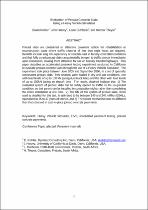JavaScript is disabled for your browser. Some features of this site may not work without it.
- ResearchSpace
- →
- Research Publications/Outputs
- →
- Conference Publications
- →
- View Item
| dc.contributor.author |
Kohler, E

|
|
| dc.contributor.author |
Harvey, JT

|
|
| dc.contributor.author |
Du Plessis, L

|
|
| dc.contributor.author |
Theyse, HL

|
|
| dc.date.accessioned | 2008-10-24T07:46:51Z | |
| dc.date.available | 2008-10-24T07:46:51Z | |
| dc.date.issued | 2008-10 | |
| dc.identifier.citation | Kohler, E, Harvey, JT, Du Plessis, L and Theyse, HL. 2008. Evaluation of precast concrete slabs using a heavy vehicle simulator. Accelerated Pavement Testing (APT) 2008, Third International Conference, Madrid, Spain, 1-3 October 2008, pp 15 | en |
| dc.identifier.isbn | 163-08-062-2 | |
| dc.identifier.uri | http://hdl.handle.net/10204/2499 | |
| dc.description | Accelerated Pavement Testing (APT) Third International Conference, 2008 | en |
| dc.description.abstract | Precast slabs are considered an attractive pavement option for rehabilitation or reconstruction cases where traffic closures of less than eight hours are required. Benefits include long life expectancy of concrete cast in factory-controlled conditions and that fully cured precast slabs can potentially be open to traffic almost immediately upon installation, making them attractive for use on heavily travelled highways. This paper describes an accelerated pavement testing experiment conducted in California to evaluate precast concrete slabs through the use of a Heavy Vehicle Simulator. The experiment took place between June 2005 and September 2006, in a set of specially constructed precast slabs. Two sections were loaded in dry and wet conditions, one with load levels of up to 100 kN (using dual truck tires) and the other with load levels of up to 150kN (using an aircraft tire). The results obtained indicate that: 1). The evaluated system of precast slabs can be safely opened to traffic in the un-grouted condition, so that panels can be installed in consecutive nights rather than completing the entire installation at one time. 2) The life of this system of precast slabs, when used as detailed for this test, is estimated to be between 140 and 240 million ESALs, equivalent to 25 to 37 years of service, and 3). The failure mechanism was no different than that observed in cast-in-place jointed concrete pavements | en |
| dc.language.iso | en | en |
| dc.subject | HVS | en |
| dc.subject | Heavy vehicle simulator | en |
| dc.subject | APT | en |
| dc.subject | Accelerated pavement testing | en |
| dc.subject | Precast concrete slabs | en |
| dc.title | Evaluation of precast concrete slabs using a heavy vehicle simulator | en |
| dc.type | Conference Presentation | en |
| dc.identifier.apacitation | Kohler, E., Harvey, J., Du Plessis, L., & Theyse, H. (2008). Evaluation of precast concrete slabs using a heavy vehicle simulator. http://hdl.handle.net/10204/2499 | en_ZA |
| dc.identifier.chicagocitation | Kohler, E, JT Harvey, L Du Plessis, and HL Theyse. "Evaluation of precast concrete slabs using a heavy vehicle simulator." (2008): http://hdl.handle.net/10204/2499 | en_ZA |
| dc.identifier.vancouvercitation | Kohler E, Harvey J, Du Plessis L, Theyse H, Evaluation of precast concrete slabs using a heavy vehicle simulator; 2008. http://hdl.handle.net/10204/2499 . | en_ZA |
| dc.identifier.ris | TY - Conference Presentation AU - Kohler, E AU - Harvey, JT AU - Du Plessis, L AU - Theyse, HL AB - Precast slabs are considered an attractive pavement option for rehabilitation or reconstruction cases where traffic closures of less than eight hours are required. Benefits include long life expectancy of concrete cast in factory-controlled conditions and that fully cured precast slabs can potentially be open to traffic almost immediately upon installation, making them attractive for use on heavily travelled highways. This paper describes an accelerated pavement testing experiment conducted in California to evaluate precast concrete slabs through the use of a Heavy Vehicle Simulator. The experiment took place between June 2005 and September 2006, in a set of specially constructed precast slabs. Two sections were loaded in dry and wet conditions, one with load levels of up to 100 kN (using dual truck tires) and the other with load levels of up to 150kN (using an aircraft tire). The results obtained indicate that: 1). The evaluated system of precast slabs can be safely opened to traffic in the un-grouted condition, so that panels can be installed in consecutive nights rather than completing the entire installation at one time. 2) The life of this system of precast slabs, when used as detailed for this test, is estimated to be between 140 and 240 million ESALs, equivalent to 25 to 37 years of service, and 3). The failure mechanism was no different than that observed in cast-in-place jointed concrete pavements DA - 2008-10 DB - ResearchSpace DP - CSIR KW - HVS KW - Heavy vehicle simulator KW - APT KW - Accelerated pavement testing KW - Precast concrete slabs LK - https://researchspace.csir.co.za PY - 2008 SM - 163-08-062-2 T1 - Evaluation of precast concrete slabs using a heavy vehicle simulator TI - Evaluation of precast concrete slabs using a heavy vehicle simulator UR - http://hdl.handle.net/10204/2499 ER - | en_ZA |






